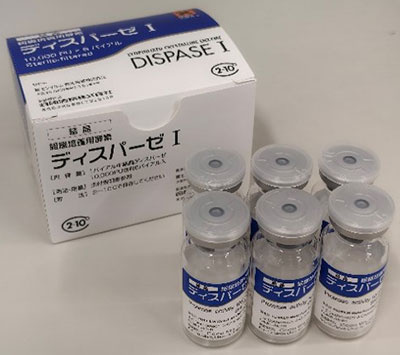[Godo Shusei] DISPASE


DISPASE is a metalloprotease that cleaves the N-terminal of neutral nonpolar amino acids in peptide chains. It detaches epithelial cells from tissues in a sheet-like structure and has long been used for cell separation and dispersion for primary culture. In addition, DISPASE, which is characterized by lower cytotoxicity and gentler cell dispersion than trypsin, collagenase, and other proteases, is also used in regenerative medicine such as ES/iPS cells.
Product information
DISPASE Ⅰ |
DISPASE Ⅱ |
|
|---|---|---|
| Description | Crystalline enzyme, sterilized | Powdered enzyme, unsterilized |
| Packaging | 6 vials | 1 g |
| Enzymatic activity | 10,000-13,000 PU / vials | 300,000-360,000 PU / g |
| Additives, etc. | The product contains calcium acetate. | The product contains dextrin and calcium acetate. |
| Storage conditions and expiration date | 2 years at 2 to 10°C (unopened) after manufacture. Once dissolved, store frozen at or below -20°C and use within 6 months. |
|
Features
- DISPASE is a neutral metalloprotease derived from Paenibacillus sp. (formerly Bacillus polymyxa). It has Zn2+ in its active center, and its activity is stabilized by Ca2+.
- Since the enzymatic activity is barely inhibited by serum components, DISPASE can be used in the presence or absence of serum. The enzyme reaction can be stopped easily by adding EDTA or diluting the reaction solution.
- DISPASE is characterized by its high ability to degrade type IV collagen and fibronectin, which constitute the basement membrane, and detaches epithelial cells from tissues in a sheet-like structure.
- DISPASE is less cytotoxic and disperses cells more gently than trypsin, collagenase, and other proteases.
- Due to the relatively wide range of reaction conditions, DISPASE is suitable for varying conditions with respect to enzyme concentration, processing time, temperature, and pH.
- DISPASE is stable at 37°C, the common cell culture temperature, and can be applied to a medium for suspension culture of some cell lines.
- This product is not manufactured from animal-derived materials and not contaminated with mycoplasma.
Action conditions and usage examples
| Enzyme concentration | 100 to 2,000 PU/mL |
|---|---|
| Solution | Buffer or medium containing Ca2+ (may contain serum) |
| Reaction time | 30 minutes to a few days |
| Reaction temperature | Room temperature to 37°C |
| Reaction pH | 6.5 to 9.0 |
| Inhibitor | EDTA, Fe3+, Fe2+, Ni2+, Cu2+, Al3+, Zn2+ |
* One PU refers to enzymatic activity that releases 1 μg of tyrosine per minute in a casein degradation assay.

References
- Matsumura T, et al. : Jpn. J. Exp. Med. 45, 377-382 (1975).
- Matsumura T, et al. : Jpn. J. Exp. Med. 45, 383-392 (1975).
- Rheinwald JG, et al. : Cell. 6, 317-330 (1975).
- Green H, et al. : Proc. Natl. Acad. Sci. USA. 76, 5665-5668 (1979).
- Kawakita T, et al. : Invest. Ophthalmol. vis. Sci. 50, 4611-4617 (2009).
- Kitano Y, et al. : Br J Dermatol. 108, 555-560 (1983).
- Thomson J.A, et al. : Science. 282, 1145-1147 (1998).
- Yan X, et al. : Stem Cells Dev. 19,469-480 (2010).
- Kurt S. Stenn, et al. : J. Invest. Dermatol. 93, 287-290 (1989).
Product List
- Open All
- Close All
For research use or further manufacturing use only. Not for use in diagnostic procedures.
Product content may differ from the actual image due to minor specification changes etc.
If the revision of product standards and packaging standards has been made, there is a case where the actual product specifications and images are different.



